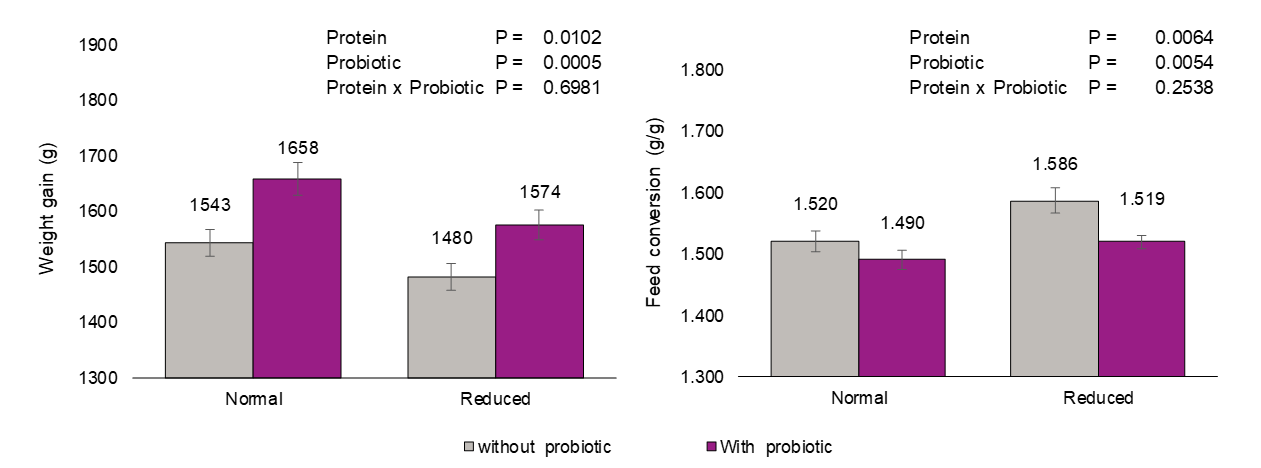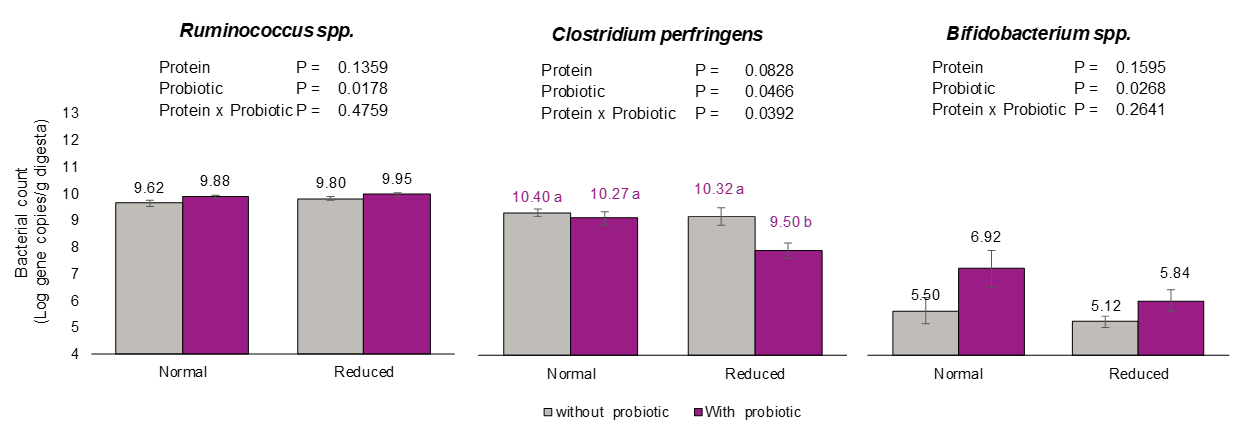



A new study into the role of Bacillus amyloliquefaciens CECT 5940 (Ecobiol®) in reduced protein diets helps shed light on necrotic enteritis disease
Necrotic enteritis disease is estimated to cost the global poultry industry $6 billion annually (Wade and Keyburn, 2015).To shed more light on the disease, a new study was conducted by Dr. Shubiao Wu at New England University in Australia to develop an alternative treatment following the ban of antibiotic growth promoters. The aim of the study was to investigate the effect of a probiotic based on Bacillus amyloliquefaciens CECT 5940 in reduced crude protein (CP) diets to amend the negative impact of challenge.
Consumption of diets containing high protein not only leads to increased nitrogen content of the digesta and excreta, but also to an enhanced substrate for C. perfringens growth (Lan et al., 2005; Timbermont et al., 2011). The experimental induction of intestinal damage to cause NE in broilers has been accomplished by infection with Eimeria before inoculation with C. perfringens (Wu et al., 2010).
Reducing dietary CP may contribute to reduced levels of C. perfringens while benefiting bacteria that use carbohydrates, for example, starch escaping digestion, as a substrate for fermentation (M'Sadeq et al., 2015).
Since B. amyloliquefaciens CECT 5940 produces amylase for starch degradation, its supplementation may favor the proliferation of lactic acid bacteria (Diaz, 2007). In addition, this bacterium may cross-feed other families of bacteria that can use lactate to produce butyrate such as Ruminococcaceae and Lachnospiraceae (Onrust et al., 2015). Butyrate is known to have a positive effect on energy metabolism and gut health (Topping and Clifton, 2001). Therefore, the reduction of CP in combination with the use of B. amyloliquefaciens CECT 5940 may have a synergic effect in the control of C. perfringens, avoiding major issues with necrotic enteritis.
The study results show that feeding probiotic based on B. amyloliquefaciens CECT 5940 promoted performance and contributed to restore the performance of broiler receiving reduced dietary protein under necrotic enteritis challenge. The supplementation of the probiotic in reduced dietary protein resulted in significant lower C. perfringens in the cecum, showing a synergic effect. In addition, the probiotic product promoted the cecal population of Bifidobacterium and Ruminococcus spp. and consequently increased cecal production of acetate, lactate and butyrate which are indicators of better gut health.
Materials and methods
Four hundred and eighty Ross 308 day-old as-hatched chicks were randomly assigned to one of the four dietary treatments with eight replicates of 15 birds each. Two basal diets were formulated. The basal diet with ‘normal’ CP content (NCP) was composed mainly of wheat, sorghum and soybean-meal and formulated to meet the amino acids recommendations for starter (day 1-10), grower (day 11-24), and finisher (day 25-35) phases, which provided 23% CP, 21.49% CP, and 19.50% CP, respectively.
The basal diet with ‘reduced’ CP content (RCP) had 2% less CP compared to the NCP diet in each phase, which was achieved by supplementation of DL-methionine, L-Lysine HCl, L-threonine, L-valine, L-isoleucine and L-arginine. The treatments consisted of: 1) NCP diet without probiotic; 2) NCP diet with 0.5g/kg Ecobiol 500® (1 x 106 CFU/g of B. amyloliquefaciens CECT 5940); 3) RCP diet without probiotic; and 4) RCP diet with 0.5g/kg Ecobiol 500®. All birds received the same challenge, which consisted of inoculation of 1mL Eimeria (5,000 sporulated oocysts each of E. maxima and E. acervulina and 2,500 of E. brunetti) at day 9 and 1ml of C. perfringens (108 CFU) at days 14 and 15.
Performance data was collected to determine the overall body weight and feed conversion in the period of 35 days. Samples of 1mL of pooled cecal contents of four birds per pen were used for DNA extraction according to Kheravii et al. (2017) and the remaining cecal sample was used for volatile fatty acid determination following the method described by Jensen et al. (1995). Data were analyzed by SPSS statistics package version 22. Mean values of the treatments were compared by the Tukey test. Statistical significance was declared at P < 0.05.
The results
Body weight gain and feed conversion ratio at 35 days are presented in Figure 1. No interactions were observed between dietary protein and the probiotic for weight gain and feed conversion, showing independent responses for both dietary protein and probiotic. Reduction of dietary protein in challenging conditions resulted in lower weight gain and higher feed conversion, but the supplementation with probiotic was able to improve weight gain and feed conversion. Consequently, the supplementation of probiotic in the reduced dietary protein was able to bring back the performance to a similar level as the group receiving a normal protein diet without probiotic.

The improvement in the performance could be partially explained by the decrease in the disturbance of the bacteria community in the cecum. The effect of the treatment for the main bacterial groups evaluated are presented in Figure 2. There was an interaction between dietary protein and probiotic supplementation for C. perfringens, meaning that the combination of reduced dietary protein and probiotic supplementation provided the lowest C. perfringens content. Probiotic alone resulted in higher cecal content of Bifidobacterium and Ruminococcus spp., while dietary protein alone was not able to affect cecal bacteria population.

Certain metabolites produced by these bacterial communities, such as the fatty acids contributes to enhance gut development. Therefore, the volatile fatty acid content in cecum was quantified and the results are presented in Figure 3. No interaction was observed between dietary protein and probiotic supplementation for the volatile fatty acids. Broilers fed diets with probiotic presented higher cecal content of acetate, lactate and butyrate, whereas the reduction in dietary protein lead to higher cecal content of acetate and butyrate but lactate was reduced.

Bacillus amyloliquefaciens CECT 5940 is a bacterium with the ability to produce amylases to enhance starch digestion and favor the proliferation of lactic acid bacteria (Diaz, 2007), which could partially explain the higher lactic acid with probiotic supplementation but not with protein reduction alone (Figure 3). Both lactate and acetate produced by members of the Bifidobacterium spp. can cross-feed other families of bacteria capable of using lactate to produce butyrate such as Ruminococcaceae and Lachnospiraceae (Onrust et al., 2015; Moens et al., 2017). Since the supplementation with Bacillus amyloliquefaciens CECT 5940 increased both Bifidobacterium and Ruminococcacus spp. (Figure 2) we can assume a cooperative benefit of this cross-feeding mechanism and, thus, resulting in high production of cecal, acetate and butyrate (Figure 3). Butyrate and acetate are known to have a positive effect on energy metabolism and gut health (Topping and Clifton, 2001) and both supplementation of the probiotic and dietary protein reduction enhanced the production of these two volatile fatty acids. In addition, butyrate plays a big role in the control of C. perfringens (Timbermont et al., 2010) and this explains the reduction observed in our study with the combination of reduced dietary protein and inclusion of probiotic (Figure 2).
Conclusion
The supplementation of probiotic product based on Bacillus amyloliquefaciens CECT 5940 promoted performance and contributed to restore the performance of broiler receiving reduced dietary protein under necrotic enteritis challenge while showing a significant decrease of cecal C. perfringens. These benefits can be attributed to the Increase in cecal Bifidobacterium and Ruminococcus spp. as well as the production of acetate, lactate and butyrate which potentially indicate a healthier gut.
For more details consult the full paper here:
https://www.sciencedirect.com/science/article/pii/S2405654520300901









